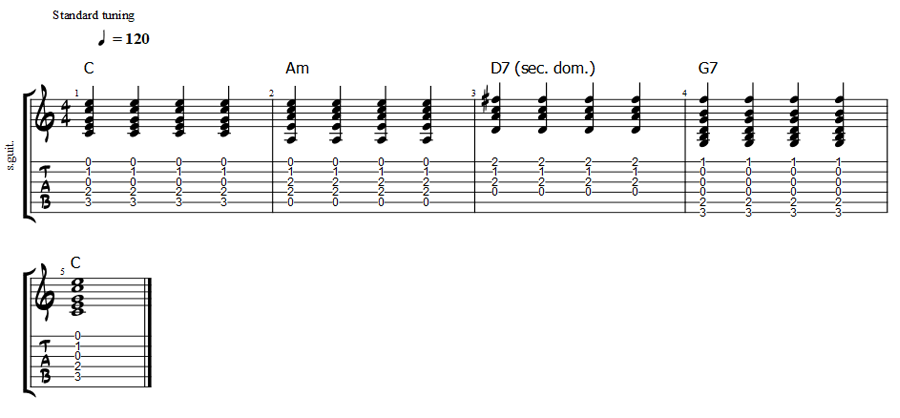How To Use Secondary Dominants
Turn a Boring Chord Progression into a Masterpiece
In this tutorial, we're going to learn a useful composing trick that will make your tunes more interesting and fun: secondary dominants! If you are tired of playing always the same, boring chord progressions, adding secondary dominants will open up a world of new options. So without further ado, let's get started!
What is A Dominant Chord
We already have talked abundantly about chord degrees and their function, so here's a quick recap just to be sure we are on the same page:
| Degree | Role | Chord | 7th Chord |
|---|---|---|---|
| 1 | Tonic | Cmaj | Cmaj7 |
| 2 | Supertonic | Dmin | Dmin7 |
| 3 | Mediant | Emin | Emin7 |
| 4 | Subdominant | Fmaj | Fmaj7 |
| 5 | Dominant | Gmaj | G7 |
| 6 | Submediant | Amin | Amin7 |
| 7 | Leading Tone | Bdim | Bmin7b5 |
As you can see on the table above, the dominant chord is the 5th chord in the scale. You simply count 5 from the tonic and you'll get its dominant chord.
The particular and unique role of the dominant chord is that it wants desperately to return to the tonic. For example, in the key of C, if you play a G7, you'll perceive a great tension that will be dissolved only if you play a C, the tonic of the key.
An analogy could be the force of gravity that pulls everything to the ground. In our case, the tonic is the ground.
Here below a quick example to help you internalize the dominant effect (I've included the tabs so that you can try it on your guitar):

Notice the tension created by the dominant chord (G7) and how that tension is released once we land on the tonic (C). Click the play button to hear this progression.
Secondary Dominants
What if we count 5 from any note in the scale, and then play a dominant chord there? We'll get all the secondary dominants in that scale!
| Degree | Chord | Secondary Dominant | Roman Notation |
|---|---|---|---|
| 1 | Cmaj | G7 | V/I |
| 2 | Dmin | A7 | V/ii |
| 3 | Emin | B7 | V/iii |
| 4 | Fmaj | C7 | V/IV |
| 5 | Gmaj | D7 | V/V |
| 6 | Amin | E7 | V/vi |
| 7 | Bdim | F#7 | V/vii |
The table above shows you the secondary dominants of each note in the scale. These new dominant chords, that are out of the original key (C in this example), can be used to enrich our chord progressions with not so obvious chords.
The last column shows the dominant chords denoted with the Roman Number Notation; it's not beginner stuff, but basically it tells you that the chord is the dominant (the "V" before "/") of a chord degree (I, ii, iii and so forth).
No Brainer Trick To Get The Dominant Using The Fretboard
On the fretboard, the dominant of a note is always 1 string up and 2 frets up from that note (except for the notes across the G and B strings, that requires you to go 3 frets up instead of 2):

This little trick is also useful for travelling the Circle Of Fifths (you simply move on the fretboard by fifths)
How To Use Secondary Dominants
As previously said, a dominant chord wants to resolve to its tonic, 5 notes below. So a good idea would be to introduce a secondary dominant right before a chord in our key.
C Dm G7 to C A7 Dm G7
For example, we have a very simple C Dm G7 chord progression:

We introduce the secondary dominant of Dm, which is A7 (V/ii in Roman Numbers Notation). Even if A7 is out of the key of C, notice the pleasant effect that it creates:

C Am Dm G7 to C Am D7 G7
We can even use a dominant of the dominant. In the key of C, G7 is the dominant; 5 notes up we find the dominant of G7, which is D7 (denoted as V/V). In the following example, we substitute the Dm chord with the secondary dominant D7:
C Am Dm G7

C Am D7 G7

Secondary Dominant: Conclusions
Secondary dominants have other use; one of the most important is exploiting them for modulating to other keys; basically, we introduce the dominant chord of the key we want to move to obtain a smoother transition; we'll talk about this topic in a specific tutorial on modulations.
Secondary dominants are not to be confused with modal interchanges, that are another way to spice up progressions, but without changing the key.
For the moment, experiment with secondary dominant by tweaking the chord sequences you already know (by the way, check my complete ebook about chord progressions).
Some chord sequences will sound good, other less, the important thing is to give you some time to play with this stuff and get your ear used to the sound of out of key chords.
An of course feel you free to break the rules; if you stumble upon something interesting that does not fall in any particular music theory category, don't discard it!
Well, that's all, I'm sure that your songwriting skills will advance with this new tool in your arsenal.
To get access to the free download area and to stay updated, subscribe here.